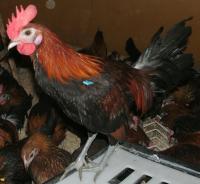What does the result mean?
The results from the project show that dominance behaviour seems to be affected by domestication since the birds bred on a low fear of human do display more aggressive behaviours. The results further show that the increased dominance is not due to the motivation to the resource in the arena since the dominance is shown already in the control sessions. Instead, the dominance, which have been shown in previous studies, seems to give an increased access to the resources presented.
When looking at the sexes seperately the differences between the lines were more clear in the females. This might depend on two reasons, either that the males mature earlier and thereby already have established their hierarchy at the age of 13 weeks which the females have not, or that the selection on tameness effects the females more.

Taking the results into consideration, they show that it is important to think about the structure of the flock when keeping chickens together, especially hens. Since hens are more common in the production due to the egg industry it is important to keep the flocks stable and not change them. As well as maybe taking the dominance levels into condsideration when further breeding on the production animals, to not elevate the motivation of taking a dominant position even more.
Another important aspect of the results is that they show that even if the breeding only is on a single trait, this can affect a large part of the genetic structure and thereby several phenotypic traits in the animals. These aspects are important to take into consideration in all animal breeding today in order to not alter animals in directions which are unwanted.
Responsible for this page:
Director of undergraduate studies Biology
Last updated:
05/06/13
